
The Sikorsky H-34 is an American piston-engined military utility helicopter originally designed by Sikorsky as an anti-submarine warfare (ASW) aircraft for the United States Navy. A development of the smaller Sikorsky H-19 Chickasaw (S-55), the H-34 was originally powered by a radial engine, but was later adapted to turbine power by the British licensee as the Westland Wessex and by Sikorsky as the S-58T. The H-34 was also produced under license in France by Sud Aviation.

Trask Coliseum is a 5,200-seat multi-purpose arena in Wilmington, North Carolina.

The Sullenberger Aviation Museum, formerly the Carolinas Aviation Museum, is an aviation museum on the grounds of Charlotte Douglas International Airport in Charlotte, North Carolina.
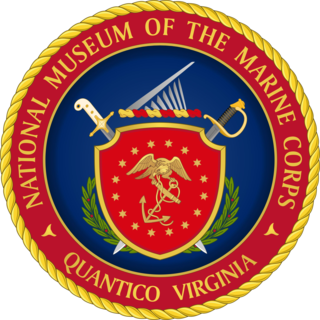
The National Museum of the Marine Corps is the historical museum of the United States Marine Corps. Located in Triangle, Virginia near Marine Corps Base Quantico, the museum opened on November 10, 2006, and is now one of the top tourist attractions in the state, drawing over 500,000 people annually.

Stone Bay is a satellite facility of Marine Corps Base Camp Lejeune in North Carolina. Based on the south side of Camp Lejeune, it is home to Weapons Training Battalion, which functions as the primary facility for weapons qualifications on Camp Lejeune, having several shooting ranges: three rifle ranges, two pistol ranges, and one long sniper range and the headquarters of United States Marine Corps Forces Special Operations Command, with the MARSOC compound on Stone Bay opening in 2010. The parent command responsible for the ranges is Weapons Training Battalion (WTBN). WTBN is broken down into two companies, Range Company and Headquarters Company. Headquarters Company contains the Marksmanship Training Unit, which is responsible for training Marines to become Combat Marksmanship Coaches and Combat Marksmanship Trainers in support of range operations.

Onslow Beach is a 12 kilometres (7.5 mi) stretch of undeveloped beach at Marine Corps Base Camp Lejeune in Onslow County, North Carolina, US. It has been used at various times for practice amphibious landings by the U.S. Navy. Presently, it is used as a recreational area by the Camp Lejeune community.
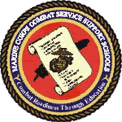
Camp Gilbert H. Johnson is a satellite camp of Marine Corps Base Camp Lejeune in Jacksonville, North Carolina and home to the Marine Corps Combat Service Support Schools (MCCSSS), where various support military occupational specialties such as administration, supply, logistics, finance, Navy corpsman and motor transport maintenance are trained. Camp Johnson is situated on Montford Point, the site of recruit training for the first African Americans to serve in the Marine Corps, known as "Montford Point Marines".
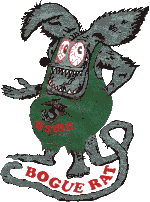
Marine Corps Auxiliary Landing Field Bogue, also known as Bogue Field, is an 875-acre (3.54 km2) landing field located on Bogue Sound that serves as a Marine Corps’ East Coast site for Field Carrier Landing Practice (FCLP). It is a sub facility of MCAS Cherry Point in Havelock in Craven County and one of three USMC facilities in Carteret County. The others include Atlantic Airfield, a Cherry Point sub installation which is sparsely manned and Radio Island shipping terminal, between Morehead City and Beaufort, which falls under control of Camp Lejeune, though it is only manned during active military operations. Another USMC facility, Oak Grove Airfield, near Pollocksville in Jones County, in also controlled by Cherry Point and in rarely manned unless training is conducted there. By Bogue Field being available for performing many of these landings at night, pilots simulate landing on an aircraft carrier or an amphibious assault ship, which provides the force with the means to forward deploy its aviation assets in order to have a more readily accessible aviation punch for the Marine Air Ground Task Force (MAGTF) commander on the battlefield.
The Waterhouse Museum was located in Toms River, New Jersey. The museum exhibited art by Colonel Charles Waterhouse, a U. S. Marine veteran of the Battle of Iwo Jima during World War II. The works at the museum depicted military scenes from the American Revolutionary War to the present with a focus on the Marine Corps. When the museum closed, the majority of Waterhouse's body of work was gifted to the United States Marine Corps.

The WWII/Korea LVT Museum is located in a Quonset hut-style building at Camp Del Mar, Marine Corps Base Camp Pendleton, California, near the Assault Amphibian School Battalion Training Command. It houses exhibits on landing vehicles tracked (LVTs) from World War II and the Korean War, including six vintage models used by the US Marine Corps. The museum highlights the service of the "Alligator" Marines during the amphibious assaults of World War II and the Korean War. In 1996, the museum won the prestigious Colonel John H. Magruder III Award from the Marine Corps Heritage Foundation.

The Marine Corps Air-Ground Museum was located at Brown Field, Marine Corps Base Quantico, Quantico, Virginia. It housed a wide variety of historic Marine Corps vehicles/tanks, equipment, artillery pieces and aircraft to trace the evolution and significance of the Marine Air-Ground Team. It also contained several pieces of foreign equipment, such as a Soviet SU-76M self-propelled howitzer. The museum closed on November 15, 2002, during the establishment of the National Museum of the Marine Corps.

The Julian C. Smith Hall is a historic building located on Julian C. Smith Drive, on Hadnot Point in Marine Corps Base Camp Lejeune, Jacksonville, North Carolina. It currently serves as the headquarters building for the II Marine Expeditionary Force and the 2d Marine Division. It is named after Lieutenant General Julian C. Smith, former commanding general of the 2d Marine Division during World War II. The Camp Lejeune address is Building H-1.

Marine Corps Air Station Cherry Point or MCAS Cherry Point is a United States Marine Corps airfield located in Havelock, North Carolina, United States, in the eastern part of the state. It was built in 1941, and was commissioned in 1942 and is currently home to the 2nd Marine Aircraft Wing.
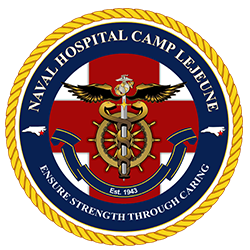
Naval Medical Center Camp Lejeune is a Defense Health Agency facility that is located on Marine Corps Base Camp Lejeune in North Carolina, USA.
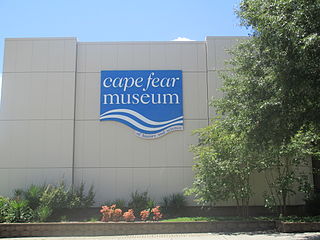
Cape Fear Museum of History and Science is a museum located at 814 Market Street in downtown Wilmington in southeastern North Carolina. Founded in 1898, it is the oldest history museum in the state.

The Marine Raider Museum is located at Raider Hall, 24191 Gilbert Road, Camp Barrett, Marine Corps Base Quantico, Quantico, Virginia. It contains exhibits related to Marine Raiders. It was originally located in Richmond, Virginia, but was moved to its current location in 2005. In 1997, the museum won the prestigious Colonel John H. Magruder III Award from the Marine Corps Heritage Foundation.

Courthouse Bay is a subdivision of Marine Corps Base Camp Lejeune and is home to the Marine Corps Engineer School, 2nd Combat Engineer Battalion, and the 2nd Assault Amphibian Battalion. Located near Camp Lejeune's southwestern Sneads Ferry gate, the sub-camp is largely self-sufficient, in that it has its own chow hall, post exchange, MWR recreation facilities, and water supply.
The Daily News is an American, English language daily newspaper headquartered in Jacksonville, North Carolina. It has served the city of Jacksonville, Marine Corps Base Camp Lejeune, and the surrounding parts of Onslow County including, Richlands, Swansboro, Sneads Ferry, Holly Ridge, and North Topsail since 1953.

The Beirut Memorial is a memorial to the 241 American peacekeepers—220 Marines, 18 sailors, and three soldiers—killed in the October 23, 1983 Beirut barracks bombing in Beirut, Lebanon. It is located outside the gate of Camp Gilbert H. Johnson, a satellite camp of Marine Corps Base Camp Lejeune, in Jacksonville, North Carolina. It is the site of an annual commemoration of the victims of the suicide attack that took their lives.
Crenatocetus is an extinct genus of protocetid early whale containing one species, Crenatocetus rayi, that lived along the Atlantic Coastal Plain of the United States during the Lutetian in the late middle Eocene. The species is named in honour of paleontologist Clayton E. Ray, former curator at the National Museum of Natural History.

















